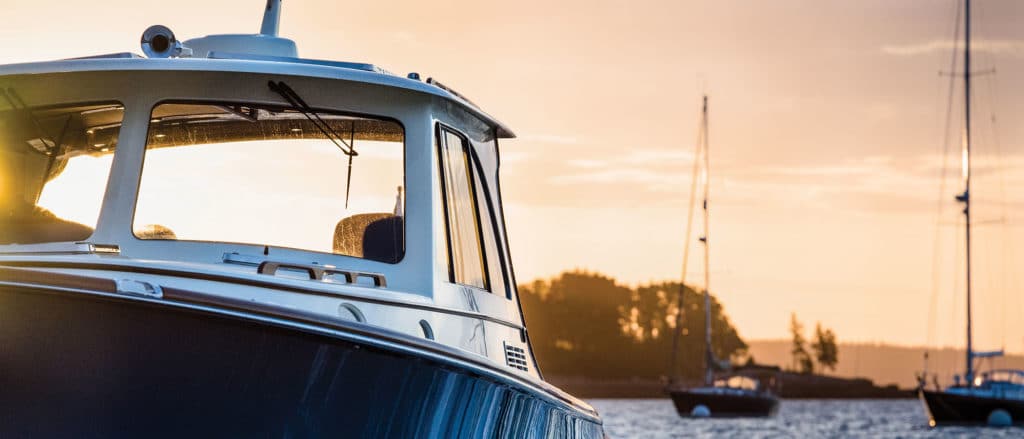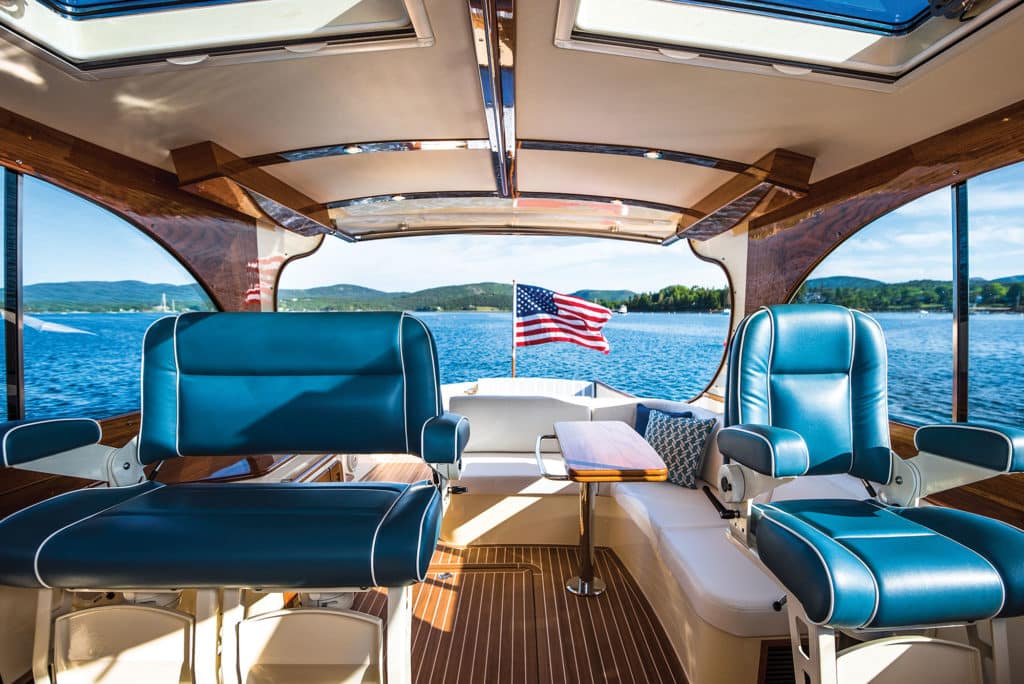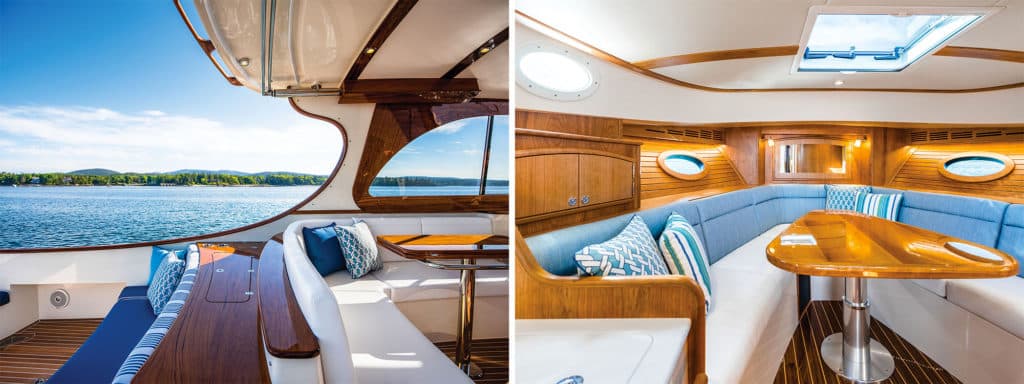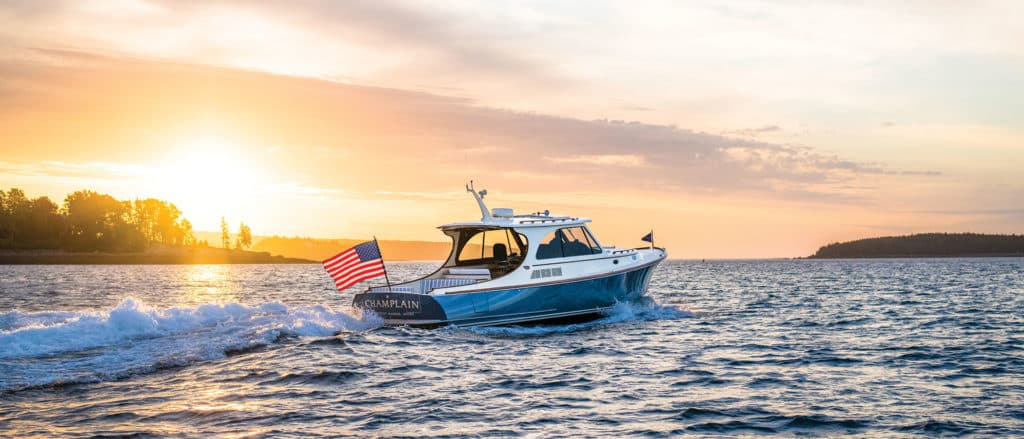
Why should an owner have to climb over his yacht’s gunwale to open the side boarding door from inside the cockpit? Hinckley Yachts asked that question. And then answered it.
With the press of a key fob, the starboard-side boarding door on the Hinckley Yachts Picnic Boat 40 slides back and tucks away under the gunwale, creating a 2-foot-wide deck-level entrance. As the door disappears, a teak step folds out, easing the transition from finger slip to boat. The system works, has had hours’ worth of endurance testing, and has zero impact on cockpit real estate, which is not the case with most inward-opening boarding doors. (The door also can be operated manually.)
That 30-second display of wow-cool technology has about 600 hours of engineering behind it, according to Hinckley. And it’s just one of many such features on the builder’s new flagship Picnic Boat, which combines today’s leading technology with traditional Downeast styling.
There are also the helm’s overhead hatches, which open with the push of a button. No more tippy-toe stretching to pop them up. And when they retract, the hatches automatically dog down. The helm windows to port and starboard also open electrically for fresh air, whether for the skipper on the double-wide Stidd helm seat or for guests on the companion seating across from it.

For days when the heat gets to be too much, air conditioning is standard at the helm. To keep guests cool, an optional SureShade Bimini top extends from the yacht’s hardtop to cover the majority of the cockpit seating.
The builder says the cockpit-seating setup is designed to make guests feel surrounded in cruising comfort. The transom bench is set relatively low into the boat so guests feel like they are sitting in the boat, not on top of it. (To me, it offered the same feeling as a sunken-living-room sofa. From the teak cockpit sole to the top of the seat cushions is 16 inches.) A second bench across from the transom, facing aft, is about 17 inches to the top of the seat cushions, again creating that same feeling but without impeding the view.
The yacht’s gadgetry, which also includes a dynamic-steering system and a second-generation JetStick (see “Easy Rider” page 89), is impressive, and equal tech advances are put into construction. Michael Peters penned the PB40’s deep-V hull form with a 19-degree transom deadrise. Supporting that form is Hinckley’s new infusion-build process.
It starts with an outer layer of Kevlar, an inner layer of carbon fiber, and a stringer grid all placed dry into the hull mold. The entire hull, grid and all, is epoxy-infused in one shot, eliminating secondary bonds. The hull is then post-cured in an 85-foot oven at Hinckley’s Advanced Composite Center in Maine. The resulting monocoque structure is relatively lightweight and tough. (The PB40 displaces around 25,000 pounds.) Hinckley guarantees its hulls and decks for life for the yacht’s original owner.

I found out how tough that build is on a snotty Narragansett Bay off Portsmouth, Rhode Island, ahead of several thunderstorms. Steady 15-knot winds soon increased to 20 to 25 knots and whipped up a 3-foot short chop. Powered with standard 480 hp Cummins diesels (550 Cummins are optional) and running into the teeth of the chop at a 27-knot cruise, the yacht chewed up the frothy whitecaps and dispatched them with malice. And I ran the boat sans trim tabs because it simply didn’t need them. At 5 feet 7 inches tall, I had clean sightlines in all directions. The tabs do come in handy when adjusting for load.
Hinckley states that the PB40’s standard-power cruise speed in good conditions is 30 knots. Given that my test vessel easily made 27 knots in less-than-ideal conditions, I could see a 30-knot cruise on a nice day. Running down-sea, the PB40 made a 37-knot top-end. Going into the sea, it made 36.5 knots at wide-open throttle.
As much as I tried, I couldn’t get the hull to bang or slap, no matter how hard-over I turned at speed or how fast I pushed it into the sea. Its performance is a solid statement about how well-packaged its hull design, construction, power plants and jet-propulsion system are. The yacht turns like a professional hockey player, decking opponents left and right. It’s a true joy to drive. I didn’t want to give up the wheel.
One of the most intriguing aspects of the PB40 is that it retains the same timeless Downeast lines as the first Hinckley Picnic Boat that launched 24 years ago. And 1,100 jet boats later, the look remains as fresh as it did then. But in this case, underneath those classic lines is 21st-century technology that’s evident from the very first step aboard.

Comfort Quotient
The Picnic Boat 40 has a 12-foot-10-inch beam, which is about a foot wider than the beam on Hinckley’s 37-footer. The yacht’s extra girth allows the dinette table, when lowered, to form a California-king berth. With 6-foot-2-inch salon headroom, three overhead hatches, and optional hull windows that flank the berth forward, the belowdecks living area feels light and airy. Satin-finish cherrywood throughout warms the space.
Easy Rider
The Picnic Boat 40 is the first yacht with Hinckley’s dynamic-steering system, giving helmsmen fewer wheel turns lock to lock at slow speeds, and a looser feel at higher speeds. I found the steering to be effortless at a 27-knot cruise and a 37-knot top hop, even while skating across a nasty, 3-foot Narragansett Bay short chop. The helm also has Hinckley’s second-generation JetStick, which allowed me to point the PB40 into the teeth of the wind, and hold station with the press of my thumb and index finger. The hydraulics that make up the system are military spec and have the same level of strength one would see in a million-dollar excavator, according to Hinckley. The vessel’s bow thruster is also hydraulic, and the whole steering system is intuitive. The water jets make movements smooth at slow and high speeds.
High-Tech Teak
Another way Hinckley blends its traditional look with today’s technology is with teak. The builder uses teak veneers over foam coring in strategic places, such as the hatches above the stowage spaces behind the cockpit seating, resulting in a lightweight yet strong hatch. That teak also has more than 10 coats of varnish on it, creating a mirrorlike finish.









